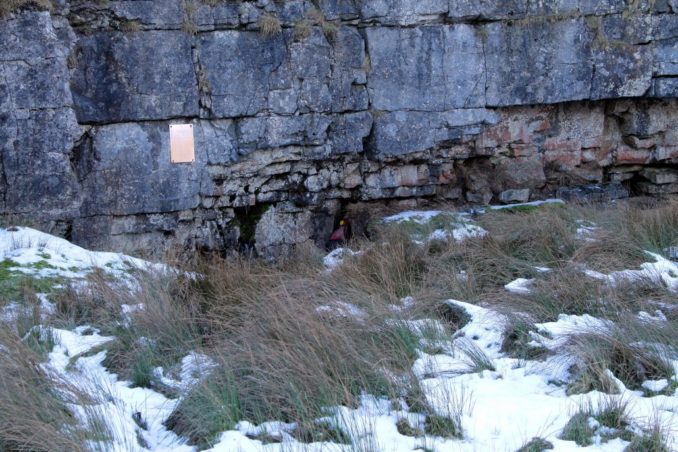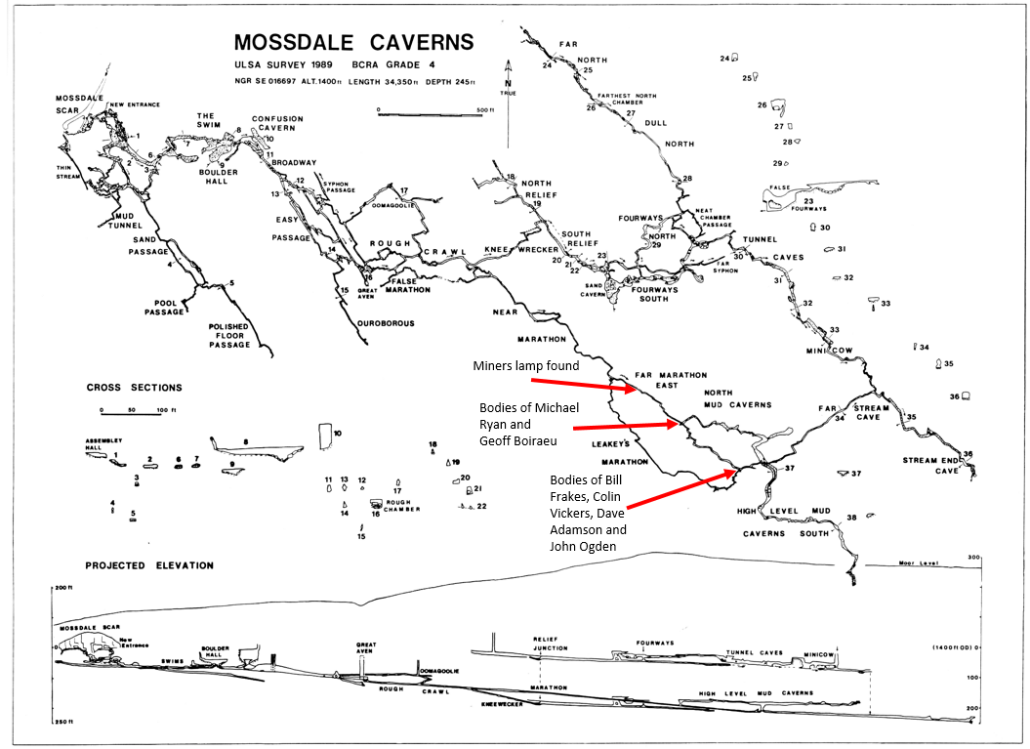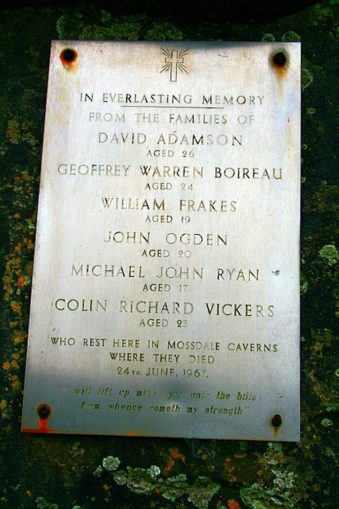
Colin Gregory – Licence CC BY 2.0
On 24rd June 1967, while I was preparing to fail my 11-Plus exam and assemblies of foppish young men were mincing around “Swinging” London in Velvet smoking jackets and frill-fronted shirts, a group of ten cavers assembled outside the Mossdale Caverns. Some had driven up from London the previous evening, through heavy rain showers, but on the moor it was dry and it was a lovely summer’s day. They had met in the Café Royal in Grassingham Main Square to discuss their visit to the far reaches of Mossdale Caverns. They were a strong team led by Dave Adamson, joined by John Ogden, Bill Frakes, Colin Vickers, Mike Ryan, Geoff Boireau, John Shepherd, Jim Cunningham, Morag Forbes (who was Dave Adamson’s fiancée) and Colette Lord. The aim of the main party was some blasting and excavation at the southern end of the High Level Mud Caverns, to see if the caverns continued to another level.
In the early afternoon, John Shepherd, Jim Cunningham, Morag Forbes and Colette Lord had completed their shorter, sightseeing trip and emerged from the caverns at around 17:00. By now it was raining slightly and the sky was overcast, but not unduly worrying. The four cavers returned to their base at How Gill Nick shooting hut where they changed and made a meal. Having, at that time, no apparent cause for anxiety, three of the party then left for Ingleton leaving Morag at the hut. The rain continued to fall lightly and at about 19:30 Morag returned to the Scar and finding little apparent difference in the water conditions, she made her way back to the shooting hut; some half-hour’s walk over the moor. Shortly after this the rain began to fall heavily and being now concerned for the safety of the underground party, she again went to the Scar, arriving there at about 21:00.
By now Mossdale Beck had risen as a flood and an extensive lake had formed in front of the Scar. Morag Forbes realised that the situation was by now grave, she ran towards Gill House Farm, just over a mile away, but found it uninhabited. She then went on to Tarbury, a further one-and-a-half miles away, where she contacted a Mr Riley who drove her down to call out the rescue organisations. The CRO put in a request for Fire Brigade personnel and pumps. The advance party of the Upper Wharfedale team arrived at the Scar at 01:15 on Sunday June 25th and found conditions very serious with the ‘New Entrance’ under some 4ft. of water. By about 02.00 hrs. Some attempt at stream diversion was under way, the Settle-Ingleton Team of CRO had been called together with as many members of the Leeds University Club as could be found.
A small dam constructed around the constricted New Entrance enabled a party of the Wharfedale Team managed to reach The Assembly Hall (just inside the cave) by 02:25, but they found the normally limited air space beyond Black Pool Sands, which provided the only way on into the cave completely submerged and impassable; the use of diving equipment at this stage would have been both futile and dangerous and therefore further progress was out of the question until the water level could be sufficiently reduced. The Fire Brigade had installed a number of portable pumps on the side of the Beck, which were sending streams of water past the Scar and down to Conistone Moor. It was clear by 03:00 that the twelve pumps were having little effect on the level of the water, despite there being no rain since midnight. By 05:00 it was decided to use heavy digging equipment to divert the Mossdale Beck in its entirety down past the Scar. This required a trench 130 yards long by 6 to 8 feet deep, together with a substantial dam to divert the Beck from the sinks at the bottom of the Scar.
At around 08:00 on Sunday 25th June the level of the beck had fallen, a telephone cable was established between the entrance and the Assembly Hall and it was possible to pass the previously submerged parts of the cave as far as the Rough Chamber. It was hoped the missing men had been trapped in the loftier sections of the Caverns and had been able to survive the flood in one of the avens (A hole in the roof of a cave passage that may be either a rather large blind roof pocket or a tributary inlet shaft into the cave system). No sign of the party was found and there was still water flowing down Rough Passage to the Knee Wrecker. It was decided to wait until the dam was more effective and the flow of water restricted. The missing men were well-equipped and more than capable of sitting out the flood for 12-48 hours, when they could get out under their own steam.
At 12:40 on the 26th a team of six was sent in to search the Marathon Passage and this team was supported by a further six. The telephone was functioning erratically and more rain was forecasted. At 17:40 on Sunday 26th it was reported that the first search party had found five bodies in the far part of Far Marathon West Passage a short distance upstream of the junction with the Far Marathon East which carries a small stream. The shock felt by the rescuers was exacerbated when it was reported there had been six men in the team, one whom was still missing. It was decided that, in view of the extremely remote chance of the sixth man having survived, further efforts to locate him and to identify the bodies would be postponed until Monday. It began to rain lightly.
Monday 27th proved to be a bad day. Heavy rain overnight had weakened the dam, the weather forecast was bad, and underground telephone communications had broken down. Eventually, when parties did get underground it was found that there was an acute shortage of men who had any real knowledge of the far parts of the cave which resulted in wastage of manpower. Finally, renewed rain caused a dangerous rise in water level behind the dam (the diversion channel presumably being of insufficient depth and width to cope with the increased flow) and all parties were withdrawn from the system by 17.00.
On Tuesday 27th the dam was strengthened by three excavators were working to build a structure around six feet high. There was now no thought of the operation being one of rescue, but rather one to determine the fate of the sixth man, to establish the identity of the bodies that had been found, to do what could be done to either bring them out, or bury them as well possible underground within the cavern. Security having been established, parties were then despatched to make a detailed search of the extremities of the Marathon Series in an attempt to locate the body of the sixth man who, it was thought, may have been swept further into the cave by the high pressure waters.
By identifying the bodies, the searchers knew that the missing man was John Ogden. On the search team the Brook brothers and Dave Howitt were known to have a most detailed knowledge of the remote parts of the cave and it did not seem likely that they would have missed anything. Therefore, it had to be concluded that Ogden’s body was either in the Marathon Passage or possibly in some nearer part of the system. The latter possibility did not appear very likely but had to be considered and steps were taken to search other parts of the cave with the idea that Ogden might have been on the way out in front of the others when the flood struck. Also, a further party which included Ken Pearce and Dr. Hugh Kidd of Derbyshire Cave Rescue Organisation and Tony Salmon of University of Leeds Speleological Association (ULSA), went in to consider the feasibility of bringing the bodies out of the cave and to legally establish the cause of death. The Brooks party arrived at the surface at about 19:30 hrs, bringing with them a number of items for identification amongst which was a piece of wet suit, which did not appear to belong to any of the other bodies and was subsequently identified as having come from Ogden’s suit. Dr. Kidd and party surfaced at about 21.00 hrs. and reported that they had failed to find any sign of Ogden and also that they considered the task of retrieving the bodies was unreasonable in view of the labour and risk to personnel it would involve.
A third search party led by Brian Boardman of the CRO entered the cave at 22:00 hrs with instructions to search a number of minor side passages opening off the Near and Far Marathon Passages. At 03:10 on Wednesday morning, Boardman reported that, whilst making an examination of the area in which three of the bodies had been found, he had located what he believed to be the body of John Ogden, jammed vertically in an extremely tight rift only some fifteen feet from the other three, but so covered with silt that only the boots, socks, laces and a part of a white helmet were visible. He had been unable to get a closer view, but the details which he was able to give agreed with the clothing Ogden was known to be wearing; thus, by a process of elimination John Ogden too was found drowned.

© CaveMaps.org CC BY 2.0 UK
From then on any further persons were forbidden from entering the caves for any reason, including the removal of communications equipment. This caused a degree of unrest among the rescuers. After some discussion with the Coroner to establish the location of the bodies and to confirm the rescuers opinion that retrieval of the bodies not realistic, it was decided that boulder obstruction should be placed in the New Entrance to prevent any unofficial entry of the cave. It was also stated that the earthworks and diversion channel would have to be removed by request of the landowner. With the weather becoming very wet everyone withdrew from the scene, but many people still had every intention of taking steps to complete the task of burying the bodies at the earliest possible opportunity.
The authorities anticipated this move by the cavers to bury their own and gave instructions to remove the dam and sealed the entrance with boulders. However there were many other potential entry ways on the 250 feet of shattered cliff face and the Lavatory Basin could still be used, although this was more dangerous. Against this background there was the deep feeling of frustration and bitterness felt by all those who had worked so long and hard at the rescue attempt. Enormous effort by both men and machines had been expended in making the cave safe for rescue purposes and apparently without any further detailed discussion with rescuers and cavers, this had been removed leaving a situation in which the cave was far more dangerous than previously, but also effectively preventing any move towards a decent burial of the dead. Several attempts to negotiate at the official level were made at once but were all rebuffed, ‘pending the inquest.’
The inquest was held in Skipton in July 1967. After a great deal of time had been spent establishing the identity and cause of death of the six men, the jury returned a verdict of ‘Death by Misadventure’ and added the rider that they considered the action taken by instruction of the Coroner (in sealing off the cave entrance) ‘to be a very wise one.’ This verdict was returned by a jury of laymen who had not heard one word of evidence or expert opinion as to the possible consequences of this action on future access to the cave and the flood hazard involved. This was the more remarkable since prior to the inquest a statement making clear the rescue hazard which had been created by this closure had been circulated to the Coroner’s Office, The West Riding Police, and The Home Office. The statement outlined the potential hazard, and recommended that the New Entrance to Mossdale should be opened, made safe, and gated with access to be closely controlled. This was arrived at after lengthy discussions with many of the rescue personnel, officials of the UWFRA and had the formal support of both the BSA and CRG. The existence of this expert opinion was ignored at the inquest, and subsequently a letter had been received from the Coroner’s Office in which the views expressed were largely rejected and the authority of the writers was questioned.
During 1971, after consultation with the relatives of the six men entombed in Mossdale Caverns, the ULSA met the parents of the deceased and explained their intention of burying the remains of the six cavers. Unanimously, the parents gave their consent and blessing to the scheme and asked that the landowner’s permission be sought. With no danger to the burial party and with as little fuss as possible, the remains were to be buried in the Mud Caverns. The task itself was relatively straight forward, although it must have been harrowing and unpleasant. It was carried out by nine Club members, eight underground and one on the surface, during a dry spell in the February. There was no fear of prior or even subsequent publicity, since only the individuals involved knew what was going on. The “sealed” New Entrance was not used.
The Mossdale Caverns deaths remains Britain’s worst caving tragedy and was one of those pivotal incidents from the 1960s that have etched their scars on my memory. The Caverns and other cave systems around the world are still explored today by hardy men and women who take life by the balls along with its risks and uncertainties. Long may they and following generations continue to do these dicey things, otherwise there is no hope from mediocrity for any of our future generations, trapped in a risk-averse world where everybody is too afraid to do anything. But you still wouldn’t get me down in a watery, enclosed cave system.

© Blown Periphery 2019
The Goodnight Vienna Audio file
Audio Player



